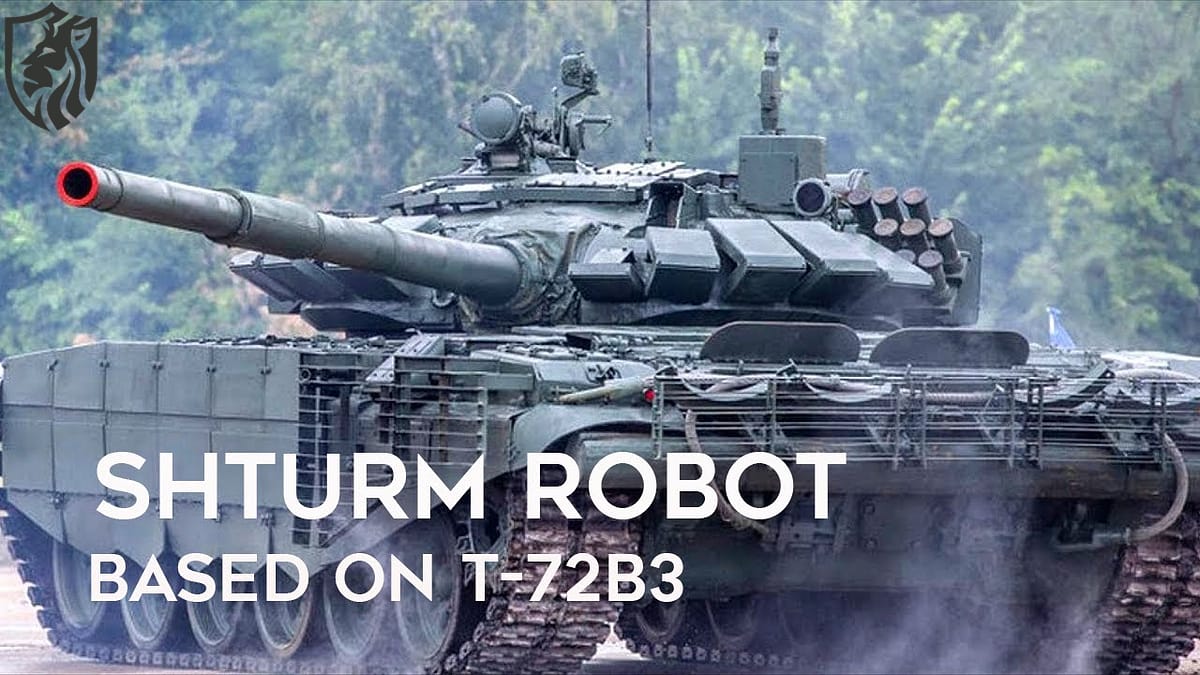
T-72 Shturm-A
Russia has introduced the T-72 Shturm-A unmanned tank, an advanced robotic variant of its iconic T-72 main battle tank. The new T-72 Shturm-A is undergoing field trials and promises to reshape urban warfare. Developed by Uralvagonzavod, the world’s largest tank manufacturer, this platform reflects Russia’s ambition to automate frontline assault roles.
The name “Shturm” means “assault” in Russian, a fitting title for a vehicle designed to spearhead attacks. The T-72 Shturm-A unmanned assault tank is meant to breach fortified positions while reducing human exposure.
Shturm-A’s Purpose-Built Design Enhances Combat Flexibility
The T-72 Shturm-A unmanned assault tank features several design changes to suit its role in complex battlefield environments. Uralvagonzavod has equipped it with an enhanced communication suite that allows remote control via a command vehicle.

This capability provides the T-72 Shturm-A unmanned assault tank an edge in contested zones, allowing Russian forces to operate the vehicle without endangering troops. Its role as a vanguard asset complements manual formations, paving the way through high-risk areas.
Key Armament Options for the T-72 Shturm-A Unmanned Assault Tank
The standard armament on the T-72 Shturm-A unmanned assault tank includes a shortened 125mm smoothbore cannon. The gun pairs with an autoloader holding 22 rounds, ensuring sustained firepower. A 7.62 mm coaxial machine gun offers secondary fire support.
Alternative configurations allow for heavier firepower. These include twin 30mm 2A42 automatic cannons and RPO-2 thermobaric rocket launchers. There are also credible reports that a 152 mm gun variant is in development. This flexibility underscores the T-72 Shturm-A unmanned assault tank’s adaptability in diverse combat scenarios.
Built for Urban Combat and Complex Terrain
The T-72 Shturm-A unmanned assault tank is designed to excel in urban operations, where conventional MBTs often face challenges. Its low-profile hull, bulldozer blades, and enhanced armor give it the tools it needs to breach barriers and withstand close-quarter threats.
This unmanned platform’s features show that Russian engineers considered the tactical demands of urban battlefields. The T-72 Shturm-A unmanned assault tank offers both brute force and precise control in dense, obstacle-rich terrain.
Implications of the T-72 Shturm-A Unmanned Assault Tank for NATO Forces
The battlefield deployment of the T-72 Shturm-A unmanned assault tank in Ukraine could change how NATO views armored threats. The platform’s unmanned nature, coupled with direct assault capability, raises the stakes for defenders.
Western forces may have to revise doctrines and invest in countermeasures such as loitering munitions or advanced anti-tank systems. The T-72 Shturm-A unmanned assault tank represents a step forward in Russia’s asymmetric strategy, balancing capability with lower personnel risk.

Challenges in Scaling T-72 Shturm-A Production
Despite its potential, the T-72 Shturm-A unmanned assault tank faces production constraints. The prolonged conflict in Ukraine has significantly reduced Russia’s reserve stock of T-72 hulls. This depletion may slow the Shturm-A’s integration into frontline units.
Nonetheless, the unveiling of the T-72 Shturm-A unmanned assault tank signals Russia’s commitment to advanced unmanned ground vehicle (UGV) programs. It also illustrates how legacy systems can evolve into sophisticated modern platforms with the right modifications.
A New Era for Unmanned Ground Vehicles
The T-72 Shturm-A unmanned assault tank is more than just a technological upgrade—it marks a shift in how militaries may conduct armored warfare. With its blend of automation, firepower, and survivability, the Shturm-A could redefine the role of tanks on future battlefields.
As the world’s major powers explore robotic warfare, the T-72 Shturm-A unmanned assault tank offers a real-world testbed for what’s to come. Its trials in Ukraine could shape doctrine far beyond Eastern Europe.






